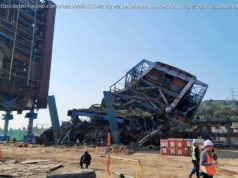They stand to lose their jobs and their homes if this diplomatic standoff drags on.
In early June, Saudi Arabia and an array of other Arab countries abruptly cut all ties with the tiny Persian Gulf nation of Qatar, triggering one of the region’s biggest diplomatic standoffs in decades. Flights were grounded. Borders were sealed. Threats were made.
And, alone in her room in the Qatari capital of Doha, migrant workers like Karen David worried about whether they’ d pay the price.
Qatar, which has just 250,000 citizens, employs an astounding 2.2 million foreign workers who build bridges, clean houses, and look after children — all for a literal pittance. The average wage among the tens of thousands of migrant workers working in construction, for instance, can be as low as $1,920 a year, or less than $6 a day.
David, who has been in Qatar for four years, earns $800 a month. It’s not a lot of money by Qatari standards, but it’s a huge amount of money by Filipino ones. She dutifully sends 80 percent of her paycheck back to the Philippines every month to support her two children: a 22-year-old son and an 18-year-old daughter.
Now, for reasons entirely beyond her control, David, and millions of other migrants, is being pushed dangerously close to homelessness and poverty.
Their plight illustrates the human cost of the growing dispute between some of Washington’s closest Middle Eastern allies. The ongoing crisis has posed a particular challenge for the Trump administration, which has struggled to balance its increasingly close relationship to Saudi Arabia with its longtime relationship to Qatar — which houses a massive American military base and is a vital intermediary to Islamist groups in the region.
Qataris are so wealthy — citizens can average up to $690,000 GDP per person — that they’ re likely to weather the crisis just fine. The Qatari government is already paying for fresh food and cows to be airlifted into the country.
That’s not the case for migrant workers like David, who are the most vulnerable members of the oil-rich country. It’s almost certain they’ ll end up bearing the brunt of this diplomatic rift.
The universe of people who lack the financial resources to ride out the battle includes the millions of Filipinos, Bangladeshis, Pakistanis, and Nepalis who build the country’s train tracks and look after the children of wealthy Qataris and white-collar expats. These migrants risk losing their jobs, their homes, and their access to basic amenities the moment the Qatari economy faces even the slightest pressure.
“We don’ t know what will happen, ” David told me in a phone interview. “What will happen if there are wars? I will have to go home without anything. I need this job.”
The problem is that she — and huge numbers of other migrant workers — may not have those jobs much longer.
Migrant workers in Qatar are employed through the Kafala labor system, which gives their employers a staggering degree of control over their lives.
The advocacy group Migrant-Rights.org gives a good explanation of the system here, but in essence, every migrant worker is tethered to a sponsor (also their employer) through a series of contracts. Without first getting their employer’s approval, workers can’ t change jobs, quit jobs, or leave the country.
These rules are enforced by the Qatari government, so if a worker quits his job without permission, the employer has the legal ability to cancel his visa, making him an illegal resident overnight; if he tries to leave the country without first getting an exit permit, he’ ll be stopped at the borders and possibly imprisoned.
In other words, migrant workers have close to no power over their own income, mobility, or well-being. This is distressing in itself, but when you add the instability introduced by the recent blockade, it becomes nightmarish.
Qatar’s economy is heavily integrated with the countries that just cut them off. Even though the government claims they have more than enough funds to stabilize their economy, no one really knows how long this standoff is going to last or how long the Qatari government can continue paying for food to be brought into the country.
Even if Qatar’s economy is able to weather this crisis as a whole, there are bound to be companies that will be forced to delay projects, scale down operations, or potentially shut down entirely.
The country’s business-owning citizens may not feel the pinch from these adjustments, but the ripple effects on migrant workers will be extensive.
Workers depend on their employers to provide the permit for them to stay in Qatar as well as to provide their physical accommodation. If these employers fold without accounting for their migrant workers, they’ ll be left quite literally homeless. And if the companies fold without providing exit permits or transferring employment permits to another firm, these migrant workers will be left stranded in Qatar without the ability find another job.
All this is made worse by the fact that a majority of migrant workers in Qatar are already living in poverty.
“Migrant workers are at the bottom of the pay chain, and they pay the highest price when there are cash flow problems, ” says Fabien Goa, a researcher with the Refugee and Migrants‘ Rights team at Amnesty International.
Take David, who is the sole breadwinner for her family. She sends 80 percent of her paycheck back to the Philippines every month to support her two children: a son who just graduated from college, and a daughter waiting to enroll in university next year to study engineering. “She’s very bright, “ David told me, her voice cracking.
David is far from alone: Most migrant workers send the bulk of their money home to support family members, so the moment their salaries are delayed, things come to a standstill for their entire family.
Migrant workers also tend to accrue debts in order to travel to Qatar and rely on a steady salary along with their substantial end-of-service benefits to pay those debts off.
According to Goa, migrants have such precarious financial situations that even the slightest disruption can send things spiraling out of control.
Since the blockade, news agencies from the Saudi-led coalition have taken a sudden interest in the fate of Qatar’s migrant workers.
“There are publications in Saudi Arabia that have weaponized this issue, ” says Adam Sobel, the director of The Workers Cup, a documentary on migrant workers in Qatar building the facilities for the 2022 World Cup. “There’s an intent to create animosity towards Qatar by releasing stories about how workers are being treated in the country.”
In the past month, the Saudi news agency Al Arabiya has published at least five different articles highlighting Qatar’s purported abuse of migrant workers helping the country prepare for the 2022 World Cup. There were virtually no articles of this kind written on Al Arabiya from January to May this year.
The Emirates News Agency, which is the official news outlet for the UAE, has also run articles this past month condemning “the tragic situation of expatriate workers, especially Asians, who are subjected to serious human rights violations in [Qatar] .”
To be clear, most of these accusations leveled against Qatar are true. What’s interesting is who is saying them — and why.
Start
United States
USA — Events The real victims of the Gulf crisis are Qatar’s 2.2 million migrant...






